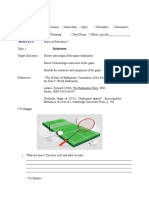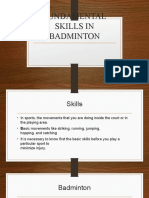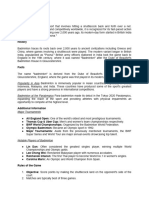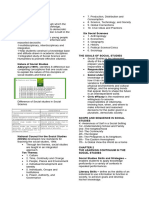CUARTO, GRACIELLE, M.
BSED SSTU 2102
P. E 103
1.What is badminton?
A racquet sport called badminton can be played by two competing individuals (singles) or two competing
pairs (doubles). Badminton House in Gloucestershire, England, where it was initially played in the middle of
the 19th century, is where the game gets its name. It is similar to tennis but is played without a ball and
instead uses a shuttlecock, a feathered or synthetic projectile. The idea is to hit the shuttlecock over the net
in a way that prevents the other team from correctly returning it in order to gain points. It's a dynamic,
quick-paced sport that calls for quickness, agility, and accuracy.
2.History of badminton.
Badminton first appeared in the Olympic Games as a demonstration sport in 1972 and as an exhibition sport
in 1988. At the 1992 Games it became a full-medal Olympic sport, with competition for men’s and women’s
singles (one against one) and doubles (two against two). Mixed doubles was introduced at the 1996 Games.
Competitive badminton is usually played indoors because even light winds affect the course of the
shuttlecock. (Recreational badminton, on the other hand, is a popular outdoor summertime activity.) The
rectangular court is 44 feet (13.4 metres) long and 17 feet (5.2 metres) wide for singles, 20 feet (6.1 metres)
wide for doubles. A net 5 feet (1.5 metres) high stretches across the width of the court at its centre. A clear
space of 4 feet (1.3 metres) around the court is needed. Play consists entirely of volleying—hitting the
shuttlecock back and forth across the net without letting it touch the floor or ground within the boundaries of
the court.
In international play, athletes compete in best-of-three-games matches. A game is played to 21 points,
provided that the winner has at least a 2-point advantage. If a 2-point advantage is never reached, the first
player or team to score 30 points wins. Points were only awarded to the serving side until 2006, when the
BWF adopted the “rally scoring” system, under which either side can score at any time.
Origins: The origins of badminton can be traced back to ancient civilizations. Games similar to badminton
were played in ancient Greece, China, and India, using a shuttlecock-type object. These early forms of the
game were often played for leisure and entertainment.
Poona Game: The modern version of badminton took shape in British India during the mid-19th century.
British army officers stationed in Pune (then Poona) introduced a game called "Poona," which involved a
shuttlecock being hit back and forth across a net. This game gained popularity among British officers, and
they brought it back to England.
Badminton House: The game's name, badminton, is derived from Badminton House in Gloucestershire,
England. The Duke of Beaufort is credited with introducing the game to his guests at a party held at
Badminton House in 1873.
Rules Standardization: The Bath Badminton Club, established in 1877, played a crucial role in
standardizing the rules of badminton. The club published the first official rules for the game, and these
regulations became widely accepted.
International Growth: Badminton gained popularity in other countries, and its international appeal grew.
The Badminton World Federation (BWF) was founded in 1934 as the International Badminton Federation
(IBF) to oversee and promote the sport globally.
�Olympic Recognition: Badminton made its debut as a demonstration sport at the 1972 Munich Olympics
and became an official Olympic sport in Barcelona in 1992.
Today, badminton is played by millions of people worldwide and is particularly popular in Asia and Europe.
It has evolved into a highly competitive sport with professional players competing at the highest levels in
international tournaments.
3. Equipment use in badminton.
Racket: Badminton rackets are lightweight and usually made of materials such as carbon fiber or aluminum.
They have a frame with strings stretched across it, creating a netted surface. Players use the racket to hit the
shuttlecock over the net.
Shuttlecock: Also known as a shuttle or birdie, the shuttlecock is a feathered or synthetic projectile with an
open conical shape. In competitive play, feathered shuttlecocks, typically made from goose feathers, are
preferred for their aerodynamic properties. Synthetic shuttlecocks are also used, especially in recreational
play.
Net and Posts: The badminton net is set up in the center of the court, supported by posts at each side. The
net divides the court into two halves for singles or doubles play.
Court: The badminton court is a rectangular area divided into two equal halves by the net. The dimensions
of the court are standardized for both singles and doubles play.
Shoes: Players wear non-marking badminton shoes to provide grip on the court surface. These shoes
typically have a gum sole that doesn't leave marks on the floor.
Apparel: Players usually wear sport-specific clothing, such as lightweight, breathable shirts and shorts.
Comfort and ease of movement are essential.
Grips and Overgrips: Players often customize the grip of their rackets with grips or overgrips to enhance
comfort and control. Grips are usually made of materials like leather or synthetic materials.
Eyewear (Optional): In some cases, players may choose to wear protective eyewear, especially at higher
levels of play, to reduce the risk of eye injuries.
4. Basic skills in badminton.
In badminton, there are several basic skills that players need to develop to play the game effectively. Here
are some fundamental skills:
Serving: A proper serve is crucial in badminton. The serve must be underhand, and the shuttlecock must be
struck below the server's waist. The serve is diagonal, starting from one service box to the opponent's service
box.
Clear: A clear is a shot hit deep into the opponent's court, pushing them towards the back. It's often used to
gain time and create a more favorable position.
Drop Shot: A drop shot involves gently tapping the shuttlecock over the net, landing it just over the
opponent's side of the court. It's an effective strategy to catch opponents off guard.
Smash: The smash is a powerful overhead shot where the player forcefully hits the shuttlecock downward
into the opponent's court. It's often used as an offensive shot to score points.
�Drive: The drive is a fast and flat shot that travels parallel to the ground. It's aimed at quickly passing the
opponent and maintaining control of the rally.
Lob: A lob is a high, looping shot that is used to send the shuttlecock over the opponent's head, forcing
them to move quickly to the back of the court.
Footwork: Good footwork is essential in badminton. Players need to move quickly and efficiently around
the court to reach the shuttlecock and maintain proper positioning.
5.Basic Rules in Badminton.
Scoring: In badminton, a match is typically played to the best of three games. The first player or pair to
reach 21 points wins a game. However, if the score reaches 20-20, the game continues until one side has a
two-point lead.
Serving and Receiving: The server must serve from below the waist, and the shuttlecock must be struck
below the waist. The receiving side must be in a stationary position until the serve is made.
Faults: Common faults include serving or receiving from the wrong side of the court, not hitting the
shuttlecock cleanly, and stepping into the opponent's court during play. If a fault is committed, the opponent
earns a point.
Court Boundaries: The court is divided into different zones, and players must ensure that the shuttlecock
lands within the boundaries during play. If the shuttlecock lands outside the boundaries, a point is awarded
to the opposing side.
6.Terminologies in badminton.
Badminton has its own set of unique terminologies that players and enthusiasts use to describe various
aspects of the game. Here are some common terminologies in badminton:
Shuttlecock: Also known as a shuttle or birdie, it is the projectile used in badminton. It has an open conical
shape and is made of feathers (in competitive play) or synthetic materials.
Racket: The badminton racket is the equipment used by players to hit the shuttlecock. It consists of a frame
with strings stretched across it.
Serve: The act of putting the shuttlecock into play at the start of a rally. The serve must be underhand and
diagonal, and it must be struck below the waist.
Clear: A shot hit deep into the opponent's court, usually to the back boundary line, to create space and gain
a strategic advantage.
Drop Shot: A gentle shot where the shuttlecock is softly tapped over the net and drops just over the
opponent's side of the court. It is used to catch opponents off guard.
Smash: A powerful overhead shot where the player forcefully hits the shuttlecock downward into the
opponent's court. It is an offensive shot often used to score points.
Drive: A fast and flat shot that travels parallel to the ground. It is aimed at quickly passing the opponent and
maintaining control of the rally.
Lob: A high, looping shot that sends the shuttlecock over the opponent's head, forcing them to move quickly
to the back of the court.
�Drop Serve: A serve that just clears the net and drops sharply, making it difficult for the opponent to return.
Deuce: When the score is tied at 20-20, it is referred to as "deuce," and the game continues until one side
has a two-point lead.
Fault: A violation of the rules, resulting in the loss of a point. Common faults include serving from the
wrong side, not hitting the shuttlecock cleanly, or stepping into the opponent's court during play.
Rally: A sequence of shots and movements between opponents until the shuttlecock hits the ground, goes
out of bounds, or a fault is committed.
Game Point: The point that, if won by the leading side, would end the game.
Match Point: Similar to game point, but it refers to the point that, if won, would end the entire match.
7.Badmintod equipment and its measurement.
Badminton equipment and court measurements are standardized to ensure fairness and consistency in the
game. Here are the key components and their measurements:
Racket:
Badminton rackets are typically 26.35 inches (67 cm) to 27.56 inches (70 cm) in length, including the
handle.
The frame of the racket must not exceed 11.02 inches (28 cm) in overall width.
Shuttlecock:
The shuttlecock has a conical shape and consists of a cork base with 16 feathers attached. In competitive
play, the feathers are usually from the left wing of a goose.
The entire shuttlecock must have a length of 2.5 to 2.8 inches (6.35 to 7.02 cm), and the base must have a
diameter of 0.62 to 0.65 inches (1.57 to 1.65 cm).
Net and Posts:
The badminton net is 5 feet (1.524 meters) in height at the center and 5 feet, 1 inch (1.55 meters) at the
posts.
The net is 20 feet (6.1 meters) in width.
Court Dimensions:
The badminton court is a rectangle that measures 44 feet (13.41 meters) in length.
The width of the court is 17 feet (5.18 meters) for doubles and 20 feet (6.1 meters) for singles play.
Service Court:
The service court is a box measuring 6 feet 6 inches (1.98 meters) by 22 feet (6.7 meters) for doubles and 5
feet 1 inch (1.55 meters) by 22 feet (6.7 meters) for singles.
The service courts are divided by the centerline and the short service line.
Markings:
The court is marked with lines, including the centerline, service lines, singles sideline, and doubles sideline.
These lines define the boundaries of the court and the service areas.
Shuttle Speed:
Shuttlecocks are categorized by speed: slow (76), medium (77), and fast (78). The numbers represent the
speed at which the shuttlecock decelerates when hit with a specific force.
Grips and Overgrips:
The handle or grip of the racket is often wrapped with a grip or overgrip for better comfort and control. The
thickness and type of grip are personal preferences for players.












































































